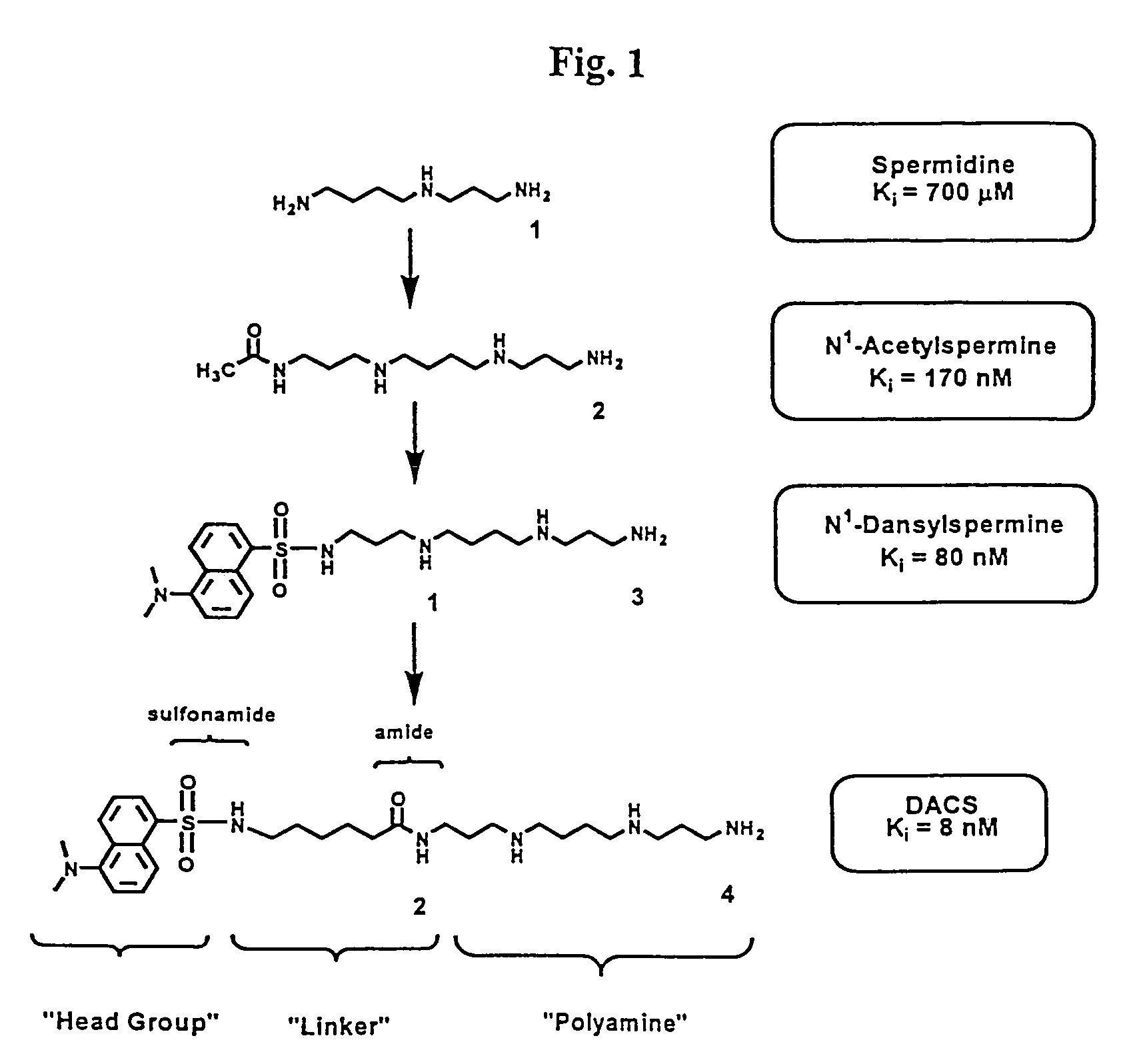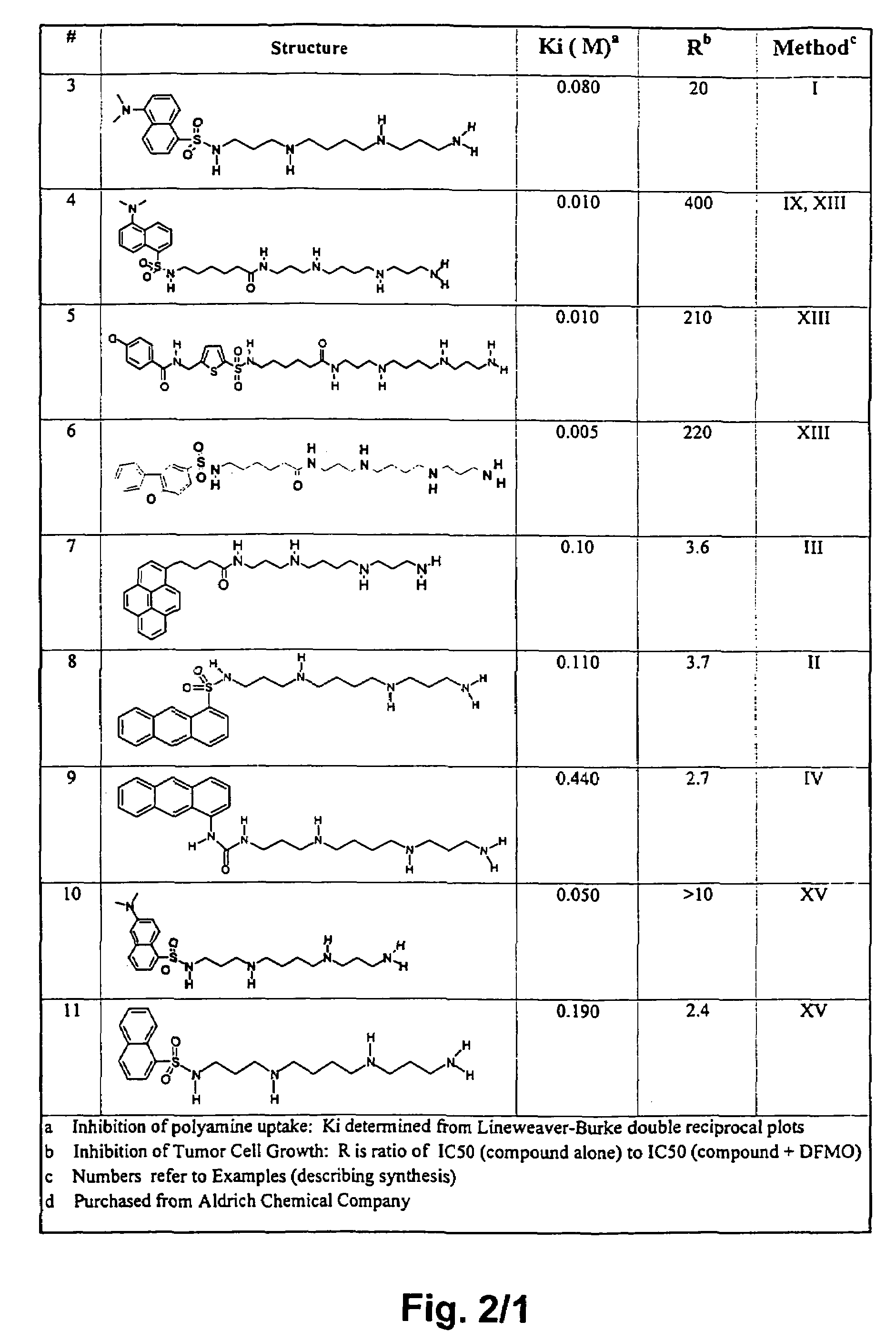Polyamine analogues as therapeutic and diagnostic agents
a technology of polyamine analogues and diagnostic agents, applied in the field of chemistry and biochemistry, can solve the problems of inability to detect high-throughput assays, etc., to achieve the effect of increasing sensitivity and screening high-throughpu
- Summary
- Abstract
- Description
- Claims
- Application Information
AI Technical Summary
Benefits of technology
Problems solved by technology
Method used
Image
Examples
example i
Synthesis of N1-dansylspermine 3
[0386]Synthesis of N1-dansylspermine is illustrated in FIG. 7. To 0.81 g (4 mmole) of spermine and 0.1 g (mmole) of triethylamine in 30 ml dry CH2Cl2 cooled down to 4C, was added dropwise 0.27 g (1 mmole) dansyl chloride dissolved in 20 ml dry CH2Cl2 over 90 minutes. The temperature was allowed to rise to ambient temperature and was stirred for 16 hours when it was filtered to remove triethylamine hydrochloride. The precipitate was washed with 25 ml CH2Cl2 and the combined CH2Cl2 extracts was extracted with 2×25 ml 5% Na2CO3 and 1×25 ml water. The CH2Cl2 was filtered through Whatman no 1 filter paper and evaporated to dryness to yield 0.45 g. Thin layer chromatography on silica gel in isopropanol:pyridine:acetic acid:water (4:1:1:2) showed no starting spermine and mainly two spots, when sprayed with 0.2% ninhydrin / ethanol. The material was dissolved in 8 ml 1.0 M ammonium acetate pH 7.4 and was chromatographed on a Biorad 70 weak cation exchanger (1.5...
example ii
Synthesis of N1-(1-pyrenylsulfonyl)spermine 15
[0387]Synthesis of N1-(1-pyrenylsulfonyl)spermine) is illustrated in FIG. 5. To 0.56 g (2.8 mmole) of spermine and 0.069 g (0.69 mmole) of triethylamine in 25 ml dry CH2Cl2 cooled down to 4° C., was added drop-wise 0.20 g (0.69 mmole) dansyl chloride 1-pyrenesulfonyl chloride dissolved in 20 ml dry CH2Cl2 over 30 minutes. The temperature was allowed to rise to ambient temperature and was stirred for 16 hours when it was filtered to remove triethylamine hydrochloride.
[0388]The precipitate was washed with 25 ml CH2Cl2 and the combined CH2Cl2 extracts were evaporated to dryness and dissolved in ethyl acetate which was extracted with twice with 25 ml 5% Na2CO3 and once with 25 ml water. The ethyl acetate was filtered through Whatman no 1 filter paper and evaporated to dryness to yield 0.26 g.
[0389]Thin layer chromatography on silica gel in isopropanol:pyridine: acetic-acid:water (4:1:1:2) showed no starting spermine and mainly two spots, whe...
example iii
Synthesis of N1-((1-carbonyl)-4-(1-pyrenyl)butane)spermine 37
[0391]Synthesis of N1-((1-carbonyl)-4-(1-pyrenyl)butane)spermine is illustrated in FIG. 6. To 0.29 g (1 mmole) of 1-pyrenebutyric acid dissolved in CHCl3 with heating were added 0.19 g (1 mmole) of EDC 0.12 g (1 mmole) of N-hydroxysuccinamide and was stirred at room temperature for 30 minutes when this solution was added drop-wise to 0.82 g (4 mmole) spennine dissolved in 20 ml CHCl3. The reaction was allowed to proceed for another 4 hours when it was diluted with an equal volume of ethylacetate. This solution was extracted with 25 ml 5% Na2CO3 and once with 25 ml water. The organic solution was filtered through Whatman no 1 filter paper and evaporated to dryness to yield 0.25 g.
[0392]Thin layer chromatography on silica gel in isopropanol:pyridine:acetic acid:water (4:1:1:2) showed no starting spermine and mainly two spots, when sprayed with 0.2% ninhydrin / ethanol.
[0393]The material was dissolved in 8 ml 1.0 M ammonium ace...
PUM
| Property | Measurement | Unit |
|---|---|---|
| Fraction | aaaaa | aaaaa |
| Length | aaaaa | aaaaa |
| Angle | aaaaa | aaaaa |
Abstract
Description
Claims
Application Information
 Login to View More
Login to View More - R&D
- Intellectual Property
- Life Sciences
- Materials
- Tech Scout
- Unparalleled Data Quality
- Higher Quality Content
- 60% Fewer Hallucinations
Browse by: Latest US Patents, China's latest patents, Technical Efficacy Thesaurus, Application Domain, Technology Topic, Popular Technical Reports.
© 2025 PatSnap. All rights reserved.Legal|Privacy policy|Modern Slavery Act Transparency Statement|Sitemap|About US| Contact US: help@patsnap.com



